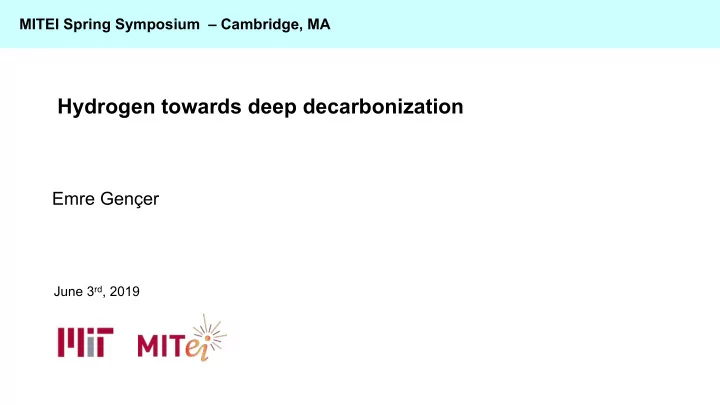

MITEI Spring Symposium – Cambridge, MA Hydrogen towards deep decarbonization Emre Gençer June 3 rd , 2019
Though the hydrogen economy concept is not new, the motivation of resurgence changes over time… 2004 1874 2015 1970 1999 Hydrogen for economy-wide deep decarbonization Energy Transportation Transportation and distributed electricity Food-Energy-Water Hard to decarbonize 1870 1970 1990 2000 2010 2020 “water will be the coal First hydrogen Increase energy security of the future” economy term Reduce environmental impacts Solar cogeneration of hydrogen and electricity Sources: EIA, 2018 2
Low-carbon electricity pivotal for economy-wide deep decarbonization, but other energy carriers like hydrogen may be necessary Low Carbon Electric Power Low Carbon Hydrogen Variable Renewables (wind, solar) Electrolysis Fossil or Bio with CCS Fossil or Bio with CCS Dispatchable low-carbon power (e.g. Nuclear, Hydro) Sources: EIA, 2018 3
The exact integration of hydrogen into the energy system is uncertain but numerous opportunities exist both on the supply and demand side Sources: MITEI 4
Not all hydrogen are created equal – The role of hydrogen in economy-wide deep decarbonization is dependent on how hydrogen is produced 5
Currently, H 2 mainly consumed by industry with co-located, centralized H 2 production to minimize delivery costs – NG reforming is predominant supply source, little other infrastructure Supply – demand picture Scale of H 2 infrastructure vs. other energy infrastructure H 2 supply Demand (total = 8 EJ) 1 100% Hydrogen Other energy sources 10 25 Storage (GJ) 3,4 ~10 6 NG: ~10 10 50% Pipelines (miles) 5 1600 NG: 300,000 65 Petroleum: 130,000 0% # of refueling 39 168,000 Other industry Refining stations 6 Chemicals Reference: U.S. Primary Energy consumption in 2018: 106.7 EJ 2 1. IRENA, Hydrogen From Renewable Power Technology Outlook for the energy transition, 2018; 2 Lawrence Berkeley National Laboratory: https://flowcharts.llnl.gov/ 3. H2 storage capacity estimated by mulitiplying storage capacity of a single storage facility (Chevron Terminal, TX) with number of facilities operating in U.S. (5) 4. U.S. EIA: https://www.eia.gov/dnav/ng/ng_stor_cap_dcu_nus_a.htm 5. U.S. Drive Hydrogen Delivery Technical Team Roadmap, 2017, 6. U.S., Department of Energy, energy.gov 6
Transportation 7
The global fuel cell electric vehicle (FCEV) car stock reached 8 000 units in April 2018. The United States represents the largest fleet with 4 500 FCEV Total FCEV fleet Toyota Mirai ($57,500) Fuel Economy = 106 km/kg H 2 Tank ~ 5 kg Range = 550 km (340 miles) Japan has more than twice as many fueling stations relative to the US (100 vs. 38) Sources: EIA, 2019 8
Exploring the life cycle greenhouse emissions of various hydrogen pathways relative to vehicle types - Car models chosen to facilitate apples-apples comparisons—i.e., minimize differences in non- powertrain features. Toyota Toyota Honda Honda Honda Camry Camry Clarity Clarity Clarity HEV ICEV PHEV FCEV BEV Interior volume (ft 3 ): 115 115 117 116 113 Sources: EIA, 2018 9
FCEV GHGs with Hydrogen via Different Methods emissions per distance (gCO ₂ e / mi) 450 xxxxxxxxxxxxxxxxxxxxxxxxxxxxxxxxxxxxxxxxxxxxx 1. Electrolysis w/ wind is cleanest. 400 2. Compared to SMR, electrolysis w 350 ICEV avg grid does not have carbon 300 benefits for FCEVs, even with ~50% HEV drop in grid carbon from 2018 to BEV 250 2050. FCEV - electrolysis 200 FCEV - SMR 3. Adding carbon capture to SMR reduces FCEV emissions to similar FCEV - SMR & CC 150 level as BEVs. FCEV - electrolysis w/ wind power 100 50 0 2018 2026 2034 2042 2050 Sources: MITEI Analysis I. Miller and E.Gençer, SESAME model 10
Power sector 11
Moving from marginal to meaningful levels of renewable power generation necessitates long term and large scale energy storage to account for seasonal and year-to-year variabilities Sources: MITEI Analysis B.Clinton and E.Gençer, SESAME model, California Generation Data 12
In California natural gas combined cycle plants increasingly dynamic role in balancing the power system – This paradigm increases marginal emission levels and will be a technical challenge for CCS integration In-state hydropower generation: 36,920 GWh in 2017 24,410 GWh in 2016 Sources: MITEI Analysis B.Clinton and E.Gençer, California Energy Commission, EPA CEMS data 13
Decoupling power generation and carbon capture to overcome low capacity factor and operational variations – Centralized SMR with CCS can fuel the existing natural gas fleet Sources: MITEI Analysis SESAME model 14
Hydrogen value chain should be significantly scaled-up to have an impact in the current energy system – 2018 H 2 production ~10 Mtons (1.2 EJ) vs. 2018 energy demand ~101.2 Quad (106.8 EJ) Hydrogen Generation ? Sources: Lawrence Livermore National Laboratory, 2018 15
The primary sector for hydrogen demand will be determined by regional dynamics Heating Energy storage & Transportation Industry Hydrogen Generation ? Sources: Map-EIA 2018 16
Takeaways - Meaningful climate change mitigation efforts must target all sectors, not just power – the versatility of H 2 makes it an appealing energy carrier to serve traditionally difficult-to-electrify end uses. - For light duty transportation (FCEV), hydrogen production determine the ranking among other options. FCEV GHGs ~quadruple with H 2 from coal gasification vs. electrolysis + wind. - Due to growth of renewable power, there is a growing need for long-term/seasonal energy storage. For hydrogen to fill this gap; - Cost and performance for production, storage, and power generation options. - Decoupling hydrogen production and power generation to use hydrogen as an energy carrier. - Infrastructure requirements. - The primary role of hydrogen in different regions is likely to be different. 17
Backup 18
Hydrogen is not a primary energy source Residential & Transportation Electric Power Industrial Commercial 29.9 EJ 40.4 EJ 12.3 EJ 24.3 EJ y 2 EJ Total: 4178 TWh 12.3 EJ 24.3 EJ (15 EJ) NG: 1468 TWh (5.3 EJ) Coal: 1146 TWh (4.1 EJ) Sources: EIA, 2018 19
Chemical energy storage steps Production Transport Storage Conversion 20
Hydrogen is not a primary energy source Hydrogen Generation ? Sources: Lawrence Livermore National Laboratory, 2018 21
Recommend
More recommend